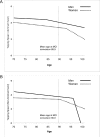The trajectory of gait speed preceding mild cognitive impairment
- PMID: 20697049
- PMCID: PMC2921227
- DOI: 10.1001/archneurol.2010.159
The trajectory of gait speed preceding mild cognitive impairment
Abstract
Objectives: To compare the trajectory of motor decline, as measured by gait speed and finger-tapping speed, between elderly people who developed mild cognitive impairment (MCI) and those who remained cognitively intact. We also sought to determine the approximate time at which the decline in motor function accelerated in persons who developed MCI.
Design: Longitudinal cohort study.
Participants: Participants were 204 healthy seniors (57.8% women) from the Oregon Brain Aging Study evaluated for up to 20 years using annual neurologic, neuropsychological, and motor examinations.
Main outcome measures: The pattern of motor decline with aging was compared using a mixed-effects model with an interaction term for age and a clinical diagnosis of MCI. The time before diagnosis of MCI, when the change in gait or finger-tapping speed accelerates, was assessed using a mixed-effects model with a change point for men and women, separately and combined, who developed MCI.
Results: The rates of change, with aging, in gait speed (P < .001) and finger-tapping speed in the dominant hand (P = .003) and nondominant hand (P < .001) were significantly different between participants who developed MCI (converters) and those who did not (nonconverters). Using a change point analysis for MCI converters, the decrease in gait speed accelerated by 0.023 m/s/y (P < .001), occurring 12.1 years before the onset of MCI. An acceleration in gait speed decline occurred earlier in men than women. For tapping speed, the change point occurred after the onset of MCI for both dominant and nondominant hands when men and women were combined.
Conclusions: Motor decline as indexed by gait speed accelerates up to 12 years before MCI. Longitudinal changes in motor function may be useful in the early detection of dementia during preclinical stages, when the utility of disease-modifying therapies would be greatest.
Figures
References
-
- Petersen RC, Doody R, Kurz A, et al. Current concepts in mild cognitive impairment. Arch Neurol. 2001 Dec;58(12):1985–1992. - PubMed
-
- Louis ED, Schupf N, Manly J, Marder K, Tang MX, Mayeux R. Association between mild parkinsonian signs and mild cognitive impairment in a community. Neurology. 2005 Apr 12;64(7):1157–1161. - PubMed
-
- Boyle PA, Wilson RS, Aggarwal NT, et al. Parkinsonian signs in subjects with mild cognitive impairment. Neurology. 2005 Dec 27;65(12):1901–1906. - PubMed
-
- Aggarwal NT, Wilson RS, Beck TL, Bienias JL, Bennett DA. Motor dysfunction in mild cognitive impairment and the risk of incident Alzheimer disease. Arch Neurol. 2006 Dec;63(12):1763–1769. - PubMed
Publication types
MeSH terms
Grants and funding
LinkOut - more resources
Full Text Sources
Other Literature Sources
Medical



